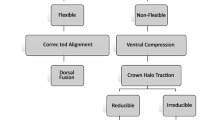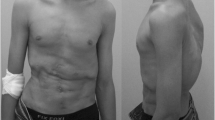Abstract
Background
Ehler-Danlos syndome (EDS) refers to a group of heritable connective tissue disorders; rare manifestations of which are cervical kyphosis and clinical myelopathy. Surgical treatment is described for the deformity in the thoracolumbar spine in adolescents but not for infantile cervical spine. Internal fixation for deformity correction in the infantile cervical spine is challenging due to the diminutive size of the bony anatomy and the lack of spinal instrumentation specifically designed for young children. We describe the first case of successful surgical treatment in an infant with a high cervical kyphotic deformity in EDS.
Case presentation
A 15-month-old female with EDS presented with several months of regression in gross motor skills in all four extremities. Imaging demonstrated 45° of kyphosis from the C2–4 levels with spinal cord compression. Corrective surgery consisted of a C3 corpectomy and C2–4 anterior fusion with allograft block and anterior fixation with dual 2 × 2 hole craniofacial miniplates, supplemented by C2–4 posterior fusion using four craniofacial miniplates fixated to the lamina. Radiographs at 20 months post-surgery demonstrated solid fusion both anteriorly and posteriorly with maintenance of correction.
Conclusions
Ehlers-Danlos syndrome may present in the pediatric population with congenital kyphosis from cervical deformity in addition to the more commonly seen thoracolumbar deformities.



Similar content being viewed by others
References
Abdalla EM, Rohrbach M, Burer C, Kraenzlin M, El-Tayeby H, Elbelbesy MF, Nabil A, Giunta C (2015) Kyphoscoliotic type of Ehlers-Danlos Syndrome (EDS VIA) in six Egyptian patients presenting with a homogeneous clinical phenotype. Eur J Pediatr 174:105–112
Rohrbach M, Vandersteen A, Yis U, Serdaroglu G, Ataman E, Chopra M, Garcia S, Jones K, Kariminejad A, Kraenzlin M, Marcelis C, Baumgartner M, Giunta C (2011) Phenotypic variability of the kyphoscoliotic type of Ehlers-Danlos syndrome (EDS VIA): clinical, molecular and biochemical delineation. Orphanet J Rare Dis 6:46
Henderson FC Sr, Austin C, Benzel E, Bolognese P, Ellenbogen R, Francomano CA, Ireton C, Klinge P, Koby M, Long D, Patel S, Singman EL, Voermans NC (2017) Neurological and spinal manifestations of the Ehlers-Danlos syndromes. Am J Med Genet C Semin Med Genet 175:195–211
Porter DA, Glotzbecker MP, Timothy Hresko M, Hedequist DJ (2017) Deep surgical site infections following pediatric cervical spine surgery. J Pediatr Orthop 37:553–556
Jasiewicz B, Potaczek T, Tesiorowski M, Lokas K (2010) Spine deformities in patients with Ehlers-Danlos syndrome, type IV—late results of surgical treatment. Scoliosis 5:26
McMaster MJ (1994) Spinal deformity in Ehlers-Danlos syndrome. Five patients treated by spinal fusion. J Bone Joint Surg Br 76:773–777
Akpinar S, Gogus A, Talu U, Hamzaoglu A, Dikici F (2003) Surgical management of the spinal deformity in Ehlers-Danlos syndrome type VI. Eur Spine J 12:135–140
Liu Y, Gao R, Zhou X, Yuan W (2011) Posterior spinal fusion for scoliosis in Ehlers-Danlos syndrome, kyphoscoliosis type. Orthopedics 34:228
Garber ST, Brockmeyer DL (2016) Management of subaxial cervical instability in very young or small-for-age children using a static single-screw anterior cervical plate: indications, results, and long-term follow-up. J Neurosurg Spine 24:892–896
Arkader A, Hosalkar HS, Drummond DS, Dormans JP (2007) Analysis of halo-orthoses application in children less than three years old. J Child Orthop 1:337–344
Garfin SR, Roux R, Botte MJ, Centeno R, Woo SL (1986) Skull osteology as it affects halo pin placement in children. J Pediatr Orthop 6:434–436
Betz RR, Lavelle WF, Samdani AF (2010) Bone grafting options in children. Spine (Phila Pa 1976) 35:1648–1654
Anderson RC, Ragel BT, Mocco J, Bohman LE, Brockmeyer DL (2007) Selection of a rigid internal fixation construct for stabilization at the craniovertebral junction in pediatric patients. J Neurosurg 107:36–42
Houten JK, Nahkla J, Ghandi S (2017) Image guidance to aid pedicle screw fixation of a lumbar fracture-dislocation injury in a toddler. World Neurosurg 105:1041 e1015–1041 e1017
Author information
Authors and Affiliations
Corresponding author
Ethics declarations
Conflict of interest
There is no conflict of interest to report.
Informed consent
Informed consent was obtained for the study subject and the study followed the institute’s committee on human research protocols.
Rights and permissions
About this article
Cite this article
Kobets, A.J., Komlos, D. & Houten, J.K. Congenital cervical kyphosis in an infant with Ehlers-Danlos syndrome. Childs Nerv Syst 34, 1411–1415 (2018). https://doi.org/10.1007/s00381-018-3750-9
Received:
Accepted:
Published:
Issue Date:
DOI: https://doi.org/10.1007/s00381-018-3750-9




